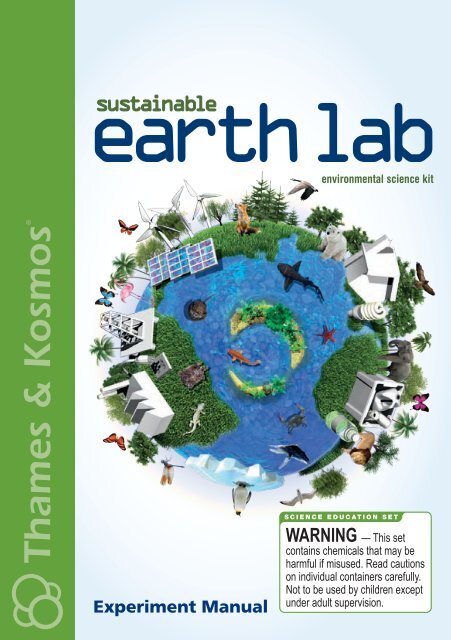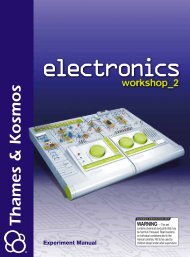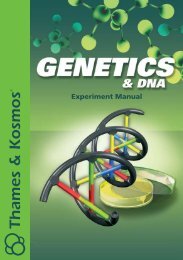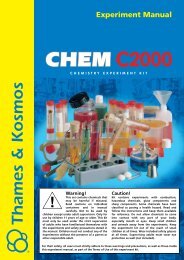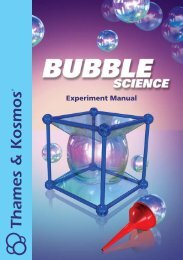638016 Sustainable Earth Lab Manual - Thames & Kosmos
638016 Sustainable Earth Lab Manual - Thames & Kosmos
638016 Sustainable Earth Lab Manual - Thames & Kosmos
Create successful ePaper yourself
Turn your PDF publications into a flip-book with our unique Google optimized e-Paper software.
sustainable<br />
Experiment <strong>Manual</strong><br />
environmental science kit
Kit Contents<br />
No. Description Qty. Part No.<br />
1 Parts from die-cut sheet 1 708 340<br />
2 Parts from paper sheet 1 708 341<br />
3 Thermometer 2 702 280<br />
4 Motor 1 016 028<br />
5 Solar cell 1 708 342<br />
6 Compass 1 706 355<br />
7 Magnifying glass 1 311 137<br />
8 Impeller wheel 1 706 540<br />
9 Drive axle 1 702 801<br />
10 Wooden stick 2 020 042<br />
11 Aluminum cup 2 706 377<br />
12 Clothespin 1 708 343<br />
13<br />
Water filter column<br />
(3 cups, 3 filter papers)<br />
1 772 874<br />
14 Garden cress seeds 1 532 122<br />
No. Description Qty. Part No.<br />
15 Petri dish 1 700 408<br />
16 Thick copper wire 1 708 344<br />
17 Ice cube tray 1 705 085<br />
18 Measuring cup, 125 ml 2 087 077<br />
19 Balloon 1 231 127<br />
20 Fabric netting 1 708 345<br />
21 Funnel 1 000 410<br />
22 Black paper 3 705 801<br />
23 White paper 1 705 802<br />
24 Battery clip 1 042 106<br />
25 Spool of wire 1 704 275<br />
26 Sand paper 1 000 275<br />
27 Drinking straw 1 707 448<br />
28 Polystyrene foam disk 1 702 235<br />
Additional Items Needed<br />
Items that are not included in the kit are indicated in italics at the beginning of each<br />
experiment. Here is a complete list:<br />
Dirt, activated charcoal, sand, cotton wool, paper towels, dishwashing liquid, colored candy-coated chocolate<br />
candies, unsweetened cocoa powder, salt, vinegar, soap, laundry detergent, bird feather, cooking oil, saucer,<br />
scissors, PETE (plastic) bottle, candle, matches, old newspapers, 4 plastic bags, scale, pencil, paper, plastic bowl,<br />
cooking spoon, dishrags, water, watch, dried peas or beans, measuring stick, glasses, baking soda, desk lamp,<br />
large glass jar or bucket, plastic wrap, felt-tip pen, deep dish, ink, ladle, pot, tape, yarn, handkerchiefs, flashlight,<br />
bucket, aluminum foil, cardboard, all-purpose glue, rock, 9-volt square battery (type 6LR61), hair dryer.<br />
1
2<br />
Table of Contents<br />
A Word to Parents and Adult Supervisors . . . .3<br />
What Does “Saving The <strong>Earth</strong>” Mean? . .4<br />
Wastewater: Battle Against Filth . . . . . .6<br />
How to Save Resources . . . . . . . . . . .11<br />
Lots and Lots of People . . . . . . . . . . .16<br />
Our Climate Needs Protection . . . . 17<br />
Heating and Insulation . . . . . . . . . . . . . . . 27<br />
Inexhaustible Energy Sources . . . . . 35<br />
Conserving Energy in Your Home . . 46<br />
Ways You Can Save Energy<br />
at Home or School . . . . . . . . . . . . 48<br />
The topic of sustainability covers a lot of different subject areas. If you have a<br />
particular interest in one of the subjects, and you want to start with the experiments<br />
in that area, just look for the corresponding symbol:<br />
Renewable<br />
Energies<br />
Natural Resource<br />
Usage<br />
Climate Change<br />
Prevention<br />
Energy<br />
Conservation<br />
Waste and<br />
Wastewater<br />
Management
14<br />
4. Holding one of the netting pieces<br />
taut with both hands, dunk it into the<br />
paper mush and then pull it straight<br />
up so it catches some of the paper<br />
mush in it.<br />
5. Lay the second piece of netting on<br />
top of it and then place both together<br />
on a stack of newspaper. Press evenly<br />
over the entire piece of netting with<br />
the palm of your hand in order to<br />
push out as much water as possible<br />
and compress the paper mass.<br />
6. Now lay the paper mass with the<br />
netting pieces on a dishrag, lay a second<br />
dishrag on top, and press it some<br />
more between the two dishrags.<br />
7. Then, carefully remove the netting<br />
and let the paper dry thoroughly on<br />
the heater.<br />
Explanation:<br />
Your homemade paper is, of course,<br />
not as nice as commercial paper.<br />
Among other things, you would have<br />
to add ingredients such as chalk to<br />
make it heavier and denser, along<br />
with other materials to prevent ink<br />
from bleeding on it. If you use printed<br />
newspaper as your raw material,<br />
the addition of laundry detergent<br />
makes your paper brighter, because<br />
it dissolves the printer’s ink from the<br />
paper fibers. In paper production, the<br />
process of removing printer’s inks and<br />
dyes is called “de-inking.”<br />
08 Experiment<br />
Gasoline consumption<br />
Automobile fuels are made from<br />
petroleum. The supplies of this material<br />
are gradually declining, while the<br />
price is constantly rising. That’s why<br />
fuel-efficient cars are becoming more<br />
and more popular. Also, combustion<br />
engines (just like heating systems)<br />
produce large quantities of carbon<br />
dioxide gas, which accumulates in<br />
<strong>Earth</strong>’s atmosphere and contributes to<br />
global warming. How much does your<br />
car consume?<br />
You will need: pencil, paper.<br />
Procedure:<br />
1. When your parents are filling the<br />
gas tank, note the number of miles on<br />
your car’s odometer and the amount<br />
of gas put in the tank. For the period<br />
during which you are making your<br />
experimental observations, ask that<br />
the tank always be filled to the same<br />
level when filling up (just to the point<br />
that the gas nozzle first shuts off, for<br />
example).<br />
Petroleum refinery for the production of<br />
gasoline and other crude oil products
2. Note these figures when a parent<br />
or other adult fills the gas tank the<br />
next time, or ask to be provided<br />
with the data.<br />
3. Calculate the average<br />
amount of gas your car<br />
uses per mile (gallons<br />
divided by the corresponding<br />
number<br />
of miles), and what<br />
the fuel consumption is<br />
per 100 miles (consumption per mile<br />
multiplied by 100).<br />
Explanation:<br />
If your car uses around 4 or 5 gallons<br />
per 100 miles,<br />
that would be<br />
about average<br />
these days. Still,<br />
if you burn a<br />
gallon of gas<br />
it creates a<br />
little under 9<br />
kilograms (20<br />
pounds) of cli- Filling station gas pump<br />
with a variety of fuels<br />
mate-damaging<br />
carbon dioxide gas. In the future,<br />
cars might be taxed according to the<br />
average quantity in weight of carbon<br />
dioxide that they emit per kilometer.<br />
This should be as far under 200 grams<br />
of carbon dioxide per mile as possible.<br />
09 Experiment<br />
Expensive dripping<br />
faucet<br />
Every American consumes, on average,<br />
well over a hundred gallons of<br />
water a day. In Europe, the average<br />
consumption is a little over one third<br />
of that. It’s important not to waste<br />
drinking water, especially due to<br />
wastefully running or dripping water<br />
taps.<br />
You will need: measuring cup, watch,<br />
pencil, paper.<br />
Procedure:<br />
1. Open a faucet just<br />
enough for the water to<br />
drip slowly.<br />
2. Place the empty measuring<br />
cup beneath it and<br />
note the time.<br />
3. Check on the experiment<br />
from time to time.<br />
Once the measuring cup is<br />
almost full, note the time<br />
again. Look at the scale<br />
on the side of the cup to see how<br />
much water is in it.<br />
4. Turn off the tap.<br />
5. Calculate how much water per hour<br />
dripped out of the faucet, and how<br />
much it would be if it dripped like<br />
that for a week.<br />
Explanation:<br />
If even just 1 liter drips out per hour,<br />
that’s 24 liters a day, or almost 9,000<br />
liters — over 2,300 gallons — a year!<br />
Even if we had<br />
plenty of water to<br />
waste, purification<br />
and distribution<br />
of water<br />
require energy<br />
too.<br />
15


